Wiggsy
Contributor
THE WHALE SHARKS OF OSLOB: Alan Wiggs
In my thirty three years of diving, I had previously only dived with a Whale Shark on one occasion – a quick off-season glimpse of a giant spotty shape in The Maldives was all I had to go by (a Whale Shark in July…?) No photos, just fading memories of the largest fish in the world rapidly disappearing into the hazy distance. My second encounter with Rhincodon typus at a little fishing town in The Philippines was to provide an entirely different experience, up close and personal with no fewer than four of these magnificent creatures.
June 28, 2012 sees me once again being lucky enough to lead a group of divers and families to Atmosphere Resort, Dumagete, on the Philippines island of Negros (it’s a tough job but somebody’s gotta do it!) This was to be our third expedition to this paradise in the Central Visayan Islands and after the success of earlier trips, we knew what to expect – superb diving with great biodiversity and gourmet cuisine at one of the best dive resorts in Asia. We were welcomed warmly and soon settled into our luxurious home on the beach, looking across to Apo Island glistening in the warm sunshine. Open Water Course candidates soon found themselves bubbling in the pool, while more experienced divers set up gear in readiness for the first dive at the house reef. Snorkellers acquainted themselves with the thriving fish life off the beach, playing with Clown Fish, pointing at slithering Snowflake Moray Eels or being buzzed by a frighteningly large Titan Triggerfish with a bad attitude and a mean set of teeth! Photographers charged batteries and greased o-rings, anticipating the magical dives to come out at Apo Island, while less energetic expeditioners relaxed by the pool or organised tours of local lakes and waterfalls.
We soon got used to glassy calm seas and hot sunshine day after day – the perfect escape from Melbourne’s dreary winter. The diving along the Dauin coastline south of Dumaguete is gaining quite a reputation for macro delights with a mixture of muck diving interspersed with healthy coral bommies – it has been described as “Lembeh with visibility”! One can expect to see various Frogfish; Ornate Ghost Pipefish; fields of Garden Eels and Nudibranchs as well as solitary Great Barracuda and pulsating schools of Red Toothed Triggerfish. And only 30 minutes away, Apo Island offers the classic blue water experience – pristine fields of hard corals, loads of Green Turtles, spiralling schools of trevally and, on the last dive, a free swimming Whale Shark. Unfortunately for me, I was restricted to the surface (or near it) as a badly broken arm in a fibreglass cast made SCUBA diving a highly risky proposition for me. A chat with diving doctor John Roth highlighted all sorts of issues including the likely increased risk of DCS, not to mention the dangers of being in a hostile environment with a rather incapacitated body part! So, I was regretfully relegated to watching the crystalline bubbles mushroom up from below. But I enjoyed the swims in the shallows, including being immersed in a school of tiny Klein’s Butterflyfish at Dauin South that actually pecked at the hairs on the back of my hand! When you are still and quiet with no tank and noisy bubbles, it is quite amazing what you see!
Highlights of the trip were many – the Filipino people themselves who were universally friendly, kind and generous with their smiles. But one of the most incredible experiences of this trip (and any trip) was to be found at the fishing village of Oslob, on the nearby island of Cebu. Starting around October 2011, local fishermen developed an unusual relationship with a large number of Whale Sharks (or “Butanding” in the local dialect). The Whale Sharks feed on shrimp (or “uyap”) over the local reefs and had started to follow the fishermen catching juvenile shrimp during the evenings. The shrimp rise with the moon and move into the shallows, followed by feeding Whale Sharks that move right into the shoreline. A few handfuls of uyap casually offered to the Whale sharks established a pattern of behaviour which has continued since.
The fishermen soon realised the tourist potential this attraction offered, and it wasn’t long before the word got out. Things rapidly got out of hand and soon Oslob was bursting at the seams. There were reports of up to 2000 people arriving in one day; clumsy touching and harassment, and finally a photo of a young lady standing (yes… standing) on the back of a Whale Shark (no matter that the aforesaid photo wasn’t actually from Oslob – the reality was that it could have been). Atmosphere Resort and the Dumaguete Dive Association acted quickly to boycott the site early in 2012 as clearly something had to be done. Management guidelines were introduced that were amongst the most stringent anywhere, though application and reinforcement were slow to develop. One of the biggest steps was to simply reduce numbers by hiking up Marine Park fees, effectively pricing out a lot of the locals (sad in some respects, but there were just too many people!) An Education Centre was set up where snorkellers were briefed on guidelines which include the obvious ones such as no touching; no flash photography and a minimum distance of 5 metres from fuselage and 6 metres from the tail. Power boats of any kind were prohibited in the Marine Park and the restriction of 30 minutes in water also acted to reduce crowding, with the feeding closed off each day at 1:00 p.m.
By early July 2012, Gabriele Holder, Dive Manager at Atmosphere Resort, was cautiously satisfied that the situation had improved and we were the first group to be given the chance to snorkel with the Whale Sharks of Oslob. We were offered this experience as a day trip with a mixture of minibus and ferry transfers over to Oslob on the island of Cebu – roughly 2 hours or so each way. Atmosphere Resort has adopted the WWF policies of no SCUBA, though this would be of doubtful benefit in any case as the Butanding are very much at the surface.
Oslob has set up a small cottage Whale Shark tourism industry, and various small stalls sell sharky T-shirts and trinkets from leaf thatch shelters. And just off the beach one can see the dugout canoes, and the occasional glimpse of the rounded dorsal fin of the Butanding. We geared up, were briefed at the centre and fumbled aboard the tiny outrigger canoes that were to be our diveboats for the morning. Upon sliding below the glassy surface, we found four Butanding in our field of view - we tried to observe the five metre rule but they often came in closer and one risked backing into the path of one whilst moving away from another! There was absolutely no crowding whatsoever. There were only a few groups of snorkelers in evidence and they were scattered down the bay into 3 or 4 feeding stations hundreds of metres apart. With some twenty (yes twenty!) Butanding in the bay that morning it was easy to disperse the groups. What I saw left me with few concerns regarding management – I have heard of worse crowding and management at Donsol and the whole situation was handled well by the local ‘shark-spotters’. Indeed, they seemed to display genuine concern, even affection for the magnificent creatures. It was inspiring. Beautiful. Unique. Athough we were only allowed thirty minutes in the water, this was thirty minutes immersed in their presence, closer than I had expected with the Whale Sharks coming to us rather than we to them.
There has been some understandable controversy over this feed, which I guess is fairly typical of similar interactions, including other shark feeds at various dive sites around the planet. It must be recognised that this is a fairly artificial experience, as the Butanding are ‘held’ in the area by the intermittent feeding from the local fishermen. The few handfuls of shrimp only supplements rather than replaces their normal feeding patterns but there are understandably concerns as to whether this may interrupt their natural migrations. Steve de Neef, Atmosphere’s Photo-Pro, is currently researching with LAMAVE (Large Marine Vertebrate Project) and has identified as many as 47 Whale sharks moving through the area, with between six and nine staying as residents. So, there is at least some evidence that many of the sharks are moving on. But, Steve also photographed “Fermin”, a large male with a worrying set of parallel gashes that appear to be the result of a boat propeller. Although only outrigger canoes with paddles are allowed at Oslob, it is possible that the association of “boat equals shrimp handout” could have led to this conflict with a power boat outside the Marine Park.
Another issue is the concerning precedent this sets, as there are now reports of a similar activity developing at Moalboal. So, where does it all end? While this may not be a perfect relationship, it certainly is preferable to what happened only a few years ago, when some of these Whale Sharks may well been captured and butchered for village consumption, despite being ‘protected’. This protection has proved inadequate in many parts of The Philippines and in 2010 a Whale Shark was found dying in the shallows of Tingloy province with every fin hacked off. Another found in June 2011 had been stabbed six times with its tail cut off. Still known as “Tofu Shark” in some parts of Asia, what we see at Oslob is certainly a more sustainable approach, though the costs and benefits need to be weighed and more research must be done. And on the positive side, the presence of so many sharks in one place provides unique opportunities for scientific research.
Yes, it is at the very least, an intrusion. But so is boatload after boatload of divers day after day hitting Blue Corner at Palau, or Barracuda point at Sipadan. We dominate, we intrude – everywhere from the slopes of The Himalaya to the penguin rookeries of Antarctica. But tourism might yet save the penguins of Antarctica, the Trevally at Sipadan or the Whale Sharks of The Philippines. By the time this article hits the stands it may all well be over, either the Butanding may simply have moved on or regulations forbidding their feeding may be introduced.
We returned to a freezing cold three degree Melbourne winter morning amazed by what we had witnessed. The Butanding were just the icing on the cake for another superb trip to The Philippines – an unexpected bonus that we hadn’t signed on for. Dumaguete, the town of the gentle people, and Atmosphere Resort will always be one of my favourite options, Whale Sharks or no. But, if you get the chance, go and make up your own mind……..
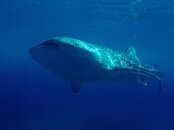
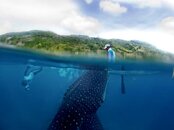
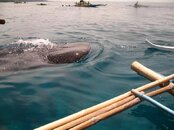
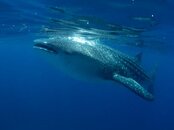
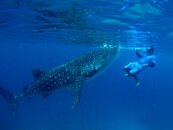
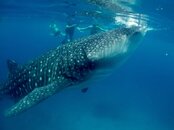
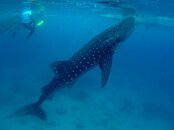
In my thirty three years of diving, I had previously only dived with a Whale Shark on one occasion – a quick off-season glimpse of a giant spotty shape in The Maldives was all I had to go by (a Whale Shark in July…?) No photos, just fading memories of the largest fish in the world rapidly disappearing into the hazy distance. My second encounter with Rhincodon typus at a little fishing town in The Philippines was to provide an entirely different experience, up close and personal with no fewer than four of these magnificent creatures.
June 28, 2012 sees me once again being lucky enough to lead a group of divers and families to Atmosphere Resort, Dumagete, on the Philippines island of Negros (it’s a tough job but somebody’s gotta do it!) This was to be our third expedition to this paradise in the Central Visayan Islands and after the success of earlier trips, we knew what to expect – superb diving with great biodiversity and gourmet cuisine at one of the best dive resorts in Asia. We were welcomed warmly and soon settled into our luxurious home on the beach, looking across to Apo Island glistening in the warm sunshine. Open Water Course candidates soon found themselves bubbling in the pool, while more experienced divers set up gear in readiness for the first dive at the house reef. Snorkellers acquainted themselves with the thriving fish life off the beach, playing with Clown Fish, pointing at slithering Snowflake Moray Eels or being buzzed by a frighteningly large Titan Triggerfish with a bad attitude and a mean set of teeth! Photographers charged batteries and greased o-rings, anticipating the magical dives to come out at Apo Island, while less energetic expeditioners relaxed by the pool or organised tours of local lakes and waterfalls.
We soon got used to glassy calm seas and hot sunshine day after day – the perfect escape from Melbourne’s dreary winter. The diving along the Dauin coastline south of Dumaguete is gaining quite a reputation for macro delights with a mixture of muck diving interspersed with healthy coral bommies – it has been described as “Lembeh with visibility”! One can expect to see various Frogfish; Ornate Ghost Pipefish; fields of Garden Eels and Nudibranchs as well as solitary Great Barracuda and pulsating schools of Red Toothed Triggerfish. And only 30 minutes away, Apo Island offers the classic blue water experience – pristine fields of hard corals, loads of Green Turtles, spiralling schools of trevally and, on the last dive, a free swimming Whale Shark. Unfortunately for me, I was restricted to the surface (or near it) as a badly broken arm in a fibreglass cast made SCUBA diving a highly risky proposition for me. A chat with diving doctor John Roth highlighted all sorts of issues including the likely increased risk of DCS, not to mention the dangers of being in a hostile environment with a rather incapacitated body part! So, I was regretfully relegated to watching the crystalline bubbles mushroom up from below. But I enjoyed the swims in the shallows, including being immersed in a school of tiny Klein’s Butterflyfish at Dauin South that actually pecked at the hairs on the back of my hand! When you are still and quiet with no tank and noisy bubbles, it is quite amazing what you see!
Highlights of the trip were many – the Filipino people themselves who were universally friendly, kind and generous with their smiles. But one of the most incredible experiences of this trip (and any trip) was to be found at the fishing village of Oslob, on the nearby island of Cebu. Starting around October 2011, local fishermen developed an unusual relationship with a large number of Whale Sharks (or “Butanding” in the local dialect). The Whale Sharks feed on shrimp (or “uyap”) over the local reefs and had started to follow the fishermen catching juvenile shrimp during the evenings. The shrimp rise with the moon and move into the shallows, followed by feeding Whale Sharks that move right into the shoreline. A few handfuls of uyap casually offered to the Whale sharks established a pattern of behaviour which has continued since.
The fishermen soon realised the tourist potential this attraction offered, and it wasn’t long before the word got out. Things rapidly got out of hand and soon Oslob was bursting at the seams. There were reports of up to 2000 people arriving in one day; clumsy touching and harassment, and finally a photo of a young lady standing (yes… standing) on the back of a Whale Shark (no matter that the aforesaid photo wasn’t actually from Oslob – the reality was that it could have been). Atmosphere Resort and the Dumaguete Dive Association acted quickly to boycott the site early in 2012 as clearly something had to be done. Management guidelines were introduced that were amongst the most stringent anywhere, though application and reinforcement were slow to develop. One of the biggest steps was to simply reduce numbers by hiking up Marine Park fees, effectively pricing out a lot of the locals (sad in some respects, but there were just too many people!) An Education Centre was set up where snorkellers were briefed on guidelines which include the obvious ones such as no touching; no flash photography and a minimum distance of 5 metres from fuselage and 6 metres from the tail. Power boats of any kind were prohibited in the Marine Park and the restriction of 30 minutes in water also acted to reduce crowding, with the feeding closed off each day at 1:00 p.m.
By early July 2012, Gabriele Holder, Dive Manager at Atmosphere Resort, was cautiously satisfied that the situation had improved and we were the first group to be given the chance to snorkel with the Whale Sharks of Oslob. We were offered this experience as a day trip with a mixture of minibus and ferry transfers over to Oslob on the island of Cebu – roughly 2 hours or so each way. Atmosphere Resort has adopted the WWF policies of no SCUBA, though this would be of doubtful benefit in any case as the Butanding are very much at the surface.
Oslob has set up a small cottage Whale Shark tourism industry, and various small stalls sell sharky T-shirts and trinkets from leaf thatch shelters. And just off the beach one can see the dugout canoes, and the occasional glimpse of the rounded dorsal fin of the Butanding. We geared up, were briefed at the centre and fumbled aboard the tiny outrigger canoes that were to be our diveboats for the morning. Upon sliding below the glassy surface, we found four Butanding in our field of view - we tried to observe the five metre rule but they often came in closer and one risked backing into the path of one whilst moving away from another! There was absolutely no crowding whatsoever. There were only a few groups of snorkelers in evidence and they were scattered down the bay into 3 or 4 feeding stations hundreds of metres apart. With some twenty (yes twenty!) Butanding in the bay that morning it was easy to disperse the groups. What I saw left me with few concerns regarding management – I have heard of worse crowding and management at Donsol and the whole situation was handled well by the local ‘shark-spotters’. Indeed, they seemed to display genuine concern, even affection for the magnificent creatures. It was inspiring. Beautiful. Unique. Athough we were only allowed thirty minutes in the water, this was thirty minutes immersed in their presence, closer than I had expected with the Whale Sharks coming to us rather than we to them.
There has been some understandable controversy over this feed, which I guess is fairly typical of similar interactions, including other shark feeds at various dive sites around the planet. It must be recognised that this is a fairly artificial experience, as the Butanding are ‘held’ in the area by the intermittent feeding from the local fishermen. The few handfuls of shrimp only supplements rather than replaces their normal feeding patterns but there are understandably concerns as to whether this may interrupt their natural migrations. Steve de Neef, Atmosphere’s Photo-Pro, is currently researching with LAMAVE (Large Marine Vertebrate Project) and has identified as many as 47 Whale sharks moving through the area, with between six and nine staying as residents. So, there is at least some evidence that many of the sharks are moving on. But, Steve also photographed “Fermin”, a large male with a worrying set of parallel gashes that appear to be the result of a boat propeller. Although only outrigger canoes with paddles are allowed at Oslob, it is possible that the association of “boat equals shrimp handout” could have led to this conflict with a power boat outside the Marine Park.
Another issue is the concerning precedent this sets, as there are now reports of a similar activity developing at Moalboal. So, where does it all end? While this may not be a perfect relationship, it certainly is preferable to what happened only a few years ago, when some of these Whale Sharks may well been captured and butchered for village consumption, despite being ‘protected’. This protection has proved inadequate in many parts of The Philippines and in 2010 a Whale Shark was found dying in the shallows of Tingloy province with every fin hacked off. Another found in June 2011 had been stabbed six times with its tail cut off. Still known as “Tofu Shark” in some parts of Asia, what we see at Oslob is certainly a more sustainable approach, though the costs and benefits need to be weighed and more research must be done. And on the positive side, the presence of so many sharks in one place provides unique opportunities for scientific research.
Yes, it is at the very least, an intrusion. But so is boatload after boatload of divers day after day hitting Blue Corner at Palau, or Barracuda point at Sipadan. We dominate, we intrude – everywhere from the slopes of The Himalaya to the penguin rookeries of Antarctica. But tourism might yet save the penguins of Antarctica, the Trevally at Sipadan or the Whale Sharks of The Philippines. By the time this article hits the stands it may all well be over, either the Butanding may simply have moved on or regulations forbidding their feeding may be introduced.
We returned to a freezing cold three degree Melbourne winter morning amazed by what we had witnessed. The Butanding were just the icing on the cake for another superb trip to The Philippines – an unexpected bonus that we hadn’t signed on for. Dumaguete, the town of the gentle people, and Atmosphere Resort will always be one of my favourite options, Whale Sharks or no. But, if you get the chance, go and make up your own mind……..











